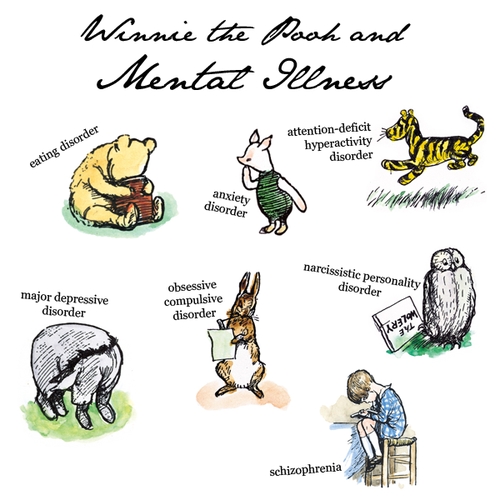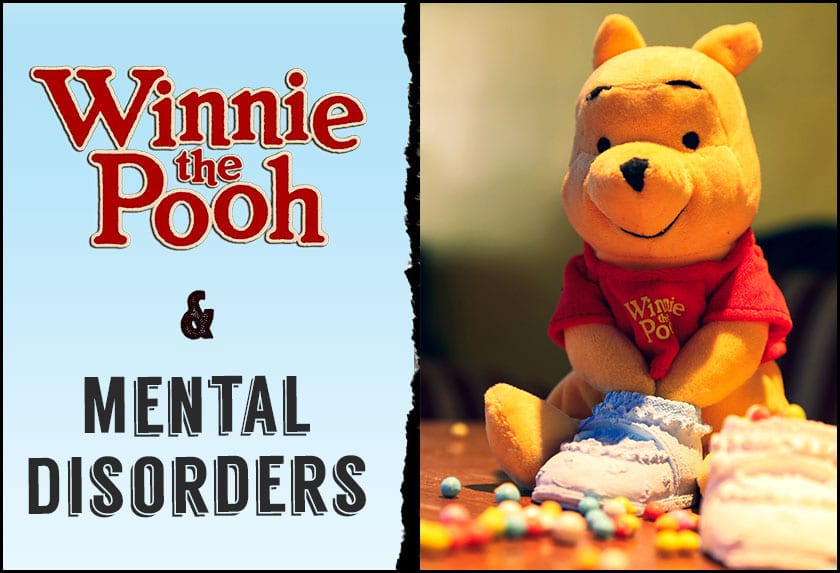Unveiling: The Mental Disorders Of Winnie The Pooh - A Deep Dive
Can a children's classic, beloved for its simplicity and charm, actually harbor a hidden world of psychological complexities? The inhabitants of the Hundred Acre Wood, with their seemingly innocent adventures, might just be portraying a surprisingly detailed map of various mental disorders. From the perpetually anxious Piglet to the compulsively organized Rabbit, a deeper look at A.A. Milne's characters suggests a far more nuanced reading than simply a collection of cuddly animal friends.
For decades, readers have delighted in the tales of Winnie the Pooh, Christopher Robin, and their companions. These stories, designed for young audiences, are often seen as a celebration of friendship, imagination, and the simple joys of life. However, taking a psychological lens to these characters unveils a different perspective. What if these endearing personalities are not just simple archetypes, but rather, representations of real-world struggles with mental health? The concept, while potentially controversial, opens up a fascinating avenue for exploring the human condition through the guise of childhood literature. The narratives, when viewed from this angle, take on a whole new level of depth, offering a unique means of engaging with complex psychological concepts.
Let's begin with the character at the center of it all: Winnie the Pooh. He's a bear of simple pleasures, mostly honey and, one might argue, a lack of worldly awareness. Is this simply a lovable naivet, or could it be indicative of something more? His forgetfulness, his tendency to be easily distracted, and his often-impulsive behavior might suggest Attention-Deficit/Hyperactivity Disorder (ADHD). The constant craving for honey could be seen as a form of seeking immediate gratification or as a maladaptive coping mechanism. This, of course, is a speculative interpretation, but the symptoms, when viewed through this lens, fit a particular pattern.
Piglet, the timid friend, offers a different perspective. His anxieties, his constant worrying, and his dependence on others for reassurance, especially on Pooh, point towards Generalized Anxiety Disorder. He is perpetually fearful, and his hesitations and insecurities define much of his character. His shrinking violet persona reflects the significant impact of his psychological state on his daily life. His vulnerability makes his friendships all the more vital, but also potentially codependent.
Eeyore, the perpetually gloomy donkey, embodies what some psychologists might identify as symptoms of persistent depressive disorder (dysthymia). His low energy, pessimism, and general lack of enthusiasm color his every interaction. While he finds moments of contentment, they are fleeting, often overshadowed by his pervasive sense of gloom. His inability to embrace happiness is not a character flaw but a reflection of a deeper sadness, impacting how he experiences the world.
Rabbit's meticulous nature and focus on rules and order make him another fascinating subject for analysis. He's obsessed with efficiency and control, and his stress increases when his plans are disrupted. These traits could potentially be linked to Obsessive-Compulsive Disorder (OCD), particularly obsessive planning and compulsive behaviors around his garden and home. This rigidity and need for structure can often clash with the more laid-back approaches of his friends, creating both comic relief and dramatic tension within the Hundred Acre Wood.
Then, there's Tigger, the bouncy, energetic tiger. His boundless enthusiasm and hyperactivity, along with his lack of impulse control, might indicate symptoms of ADHD or even bipolar disorder, especially if his moods swing from exuberance to moments of discouragement. His optimism is infectious, but there is also an underlying element of potential recklessness to his character. He frequently leaps before he looks, sometimes creating a sense of danger, and often needing the intervention of his more grounded friends.
Christopher Robin, the only human character, holds a unique position. He serves as the glue that holds the Hundred Acre Wood together, often acting as a caretaker to his friends. His compassion, understanding, and ability to connect with the animals highlight his role as a source of stability. However, there is an argument to be made that he is possibly experiencing, through his empathy with his friends, something akin to the caregiver effect. The weight of taking care of his friends, when seen through this light, adds another layer to his character and offers a more complex view of the story.
The notion of applying a psychological lens to children's literature raises many questions. Is it simply an exercise in creative interpretation, or could these allegorical characters offer insights into how we perceive mental health? Does assigning diagnostic labels to fictional characters serve a purpose? The key isn't to diagnose fictional figures but rather to use the characters and their traits as a means of exploring the nuances of real-life mental health conditions. The Hundred Acre Wood, when seen through this lens, transforms into a relatable microcosm of human experience, filled with joys, difficulties, and the enduring power of companionship.
The debate surrounding the mental health of Winnie the Pooh and his friends should not be seen as a definitive clinical diagnosis. Instead, it should be understood as a starting point for discussion and understanding. These stories can inspire us to explore the complexities of mental health, encouraging empathy, acceptance, and a deeper appreciation for the diverse ways individuals experience the world. The ability to find different psychological themes in beloved books suggests that our minds constantly try to decipher meaning and patterns in all aspects of life. The psychological interpretation of these characters can also teach us more about ourselves.
Below is a table summarizing the hypothetical psychological profiles of some of the main characters in Winnie-the-Pooh:
| Character | Possible Mental Health Considerations | Supporting Behaviors/Traits |
|---|---|---|
| Winnie the Pooh | Attention-Deficit/Hyperactivity Disorder (ADHD) | Forgetfulness, impulsive behavior, constant desire for immediate gratification, easily distracted. |
| Piglet | Generalized Anxiety Disorder | Chronic worrying, fearfulness, insecurity, reliance on others for reassurance. |
| Eeyore | Persistent Depressive Disorder (Dysthymia) | Low energy, pessimism, lack of enthusiasm, pervasive sense of gloom. |
| Rabbit | Obsessive-Compulsive Disorder (OCD) | Meticulous planning, obsession with order, compulsive behaviors, stress when plans are disrupted. |
| Tigger | Attention-Deficit/Hyperactivity Disorder (ADHD) or Bipolar Disorder | Boundless energy, impulsivity, constant activity, mood swings. |
| Christopher Robin | Potential Caregiver Effect | Compassion, understanding, responsible, source of stability, empathetic. |
It is important to remember that the interpretations presented are speculative. They are meant to facilitate discussion and promote greater sensitivity to mental health issues, not to offer a formal diagnosis for any character. The aim is to examine the possible presence of different mental health concerns, which allows readers to find a better comprehension of these challenging concepts.
The beauty of the world of Winnie-the-Pooh lies in its simplicity and the profound, understated lessons it imparts. While these psychological insights are interesting, the enduring value of the stories still lies in their representation of friendship, empathy, and the beauty of accepting oneself and others for who they are.
This perspective also invites us to consider the role of empathy and understanding in relationships. By acknowledging the challenges faced by these characters, we can begin to develop a more compassionate view of human behavior. The stories teach us that even the most troubled characters are worthy of love and support, and that understanding is key to building strong relationships.
The underlying theme is the importance of human connection and support. The characters rely on each other, providing comfort, guidance, and acceptance. Even in the face of adversity, they find ways to support each other and celebrate their differences. This creates a profound lesson that can be applied to all the intricacies of human relationships. The message is clear that with friendship and kindness, even the hardest of circumstances can be overcome.
This approach of looking at the characters has become popular because it offers a fresh and thoughtful way of engaging with the material. Instead of viewing the characters as flat stereotypes, the readers are encouraged to delve deeper into the layers of their characters. The interpretation of their behaviors can offer a new level of connection, inviting the readers to relate them to their own experiences and the lives of the people around them.
In conclusion, the seemingly simplistic world of Winnie-the-Pooh presents a potentially complex portrait of mental health concerns. By taking a psychological approach to the characters, readers can embark on a journey of exploration into the human condition. These engaging tales may inspire deeper conversations about mental well-being, promote empathy and understanding, and ultimately remind us of the significance of friendship, compassion, and acceptance. The inhabitants of the Hundred Acre Wood, in their own, unique ways, remind us that even in the darkest of times, a little bit of honey and a good friend can make all the difference.


